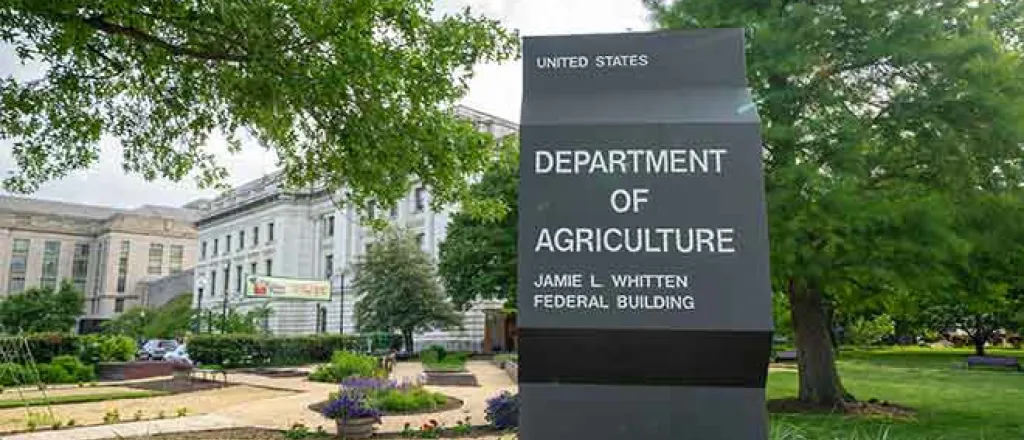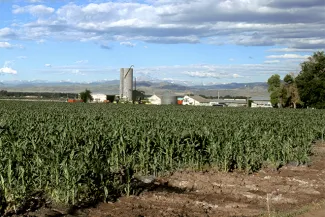
Benefits for Colorado, blow to department workforce foreseen in USDA relocation
The U.S. Department of Agriculture’s plan to relocate thousands of Washington, D.C., employees to five regional hubs including Fort Collins could be a boon for Colorado-based research while undercutting the department’s overall workforce, agricultural economists said.
The department wants to relocate up to 2,600 of its 4,600 D.C.-area employees to regional offices in Fort Collins; Raleigh, North Carolina; Kansas City, Missouri; Indianapolis; and Salt Lake City. The planned move would also phase out the USDA’s nine regional U.S. Forest Service offices primarily into a single location in Fort Collins.

Corn field in Larimer county, Colorado. Courtesy USDA
Although the move will bring more experts and resources to Fort Collins, it will also mean turnover at the USDA, Colorado State University agricultural economics professor Dawn Thilmany said. The department, which researches and regulates sectors like farming, food safety and natural resources, employs about 100,000 people.
“I think there’s a lot to be said for the USDA being more locally organized, and it will benefit my grad students, having so much more of the talent affiliated with USDA in our backyard,” Thilmany said. “But, regardless of how many people actually leave the department, because we don’t know what the number will be, it looks like it will be a significant disruption.”
The department is making the move “to bring USDA closer to the people it serves while also providing a more affordable cost of living for USDA employees,” according to a statement from the department.
The statement said that Fort Collins was chosen as one of the relocation hubs “based on its existing USDA and Forest Service presence, proximity to agricultural communities and affordability relative to the Washington metro area — one of the most expensive in the country.”
Opportunities for northern Colorado
Some Colorado lawmakers have expressed their approval of the planned move. Senator John Hickenlooper said in a post on X that “Fort Collins will be a great home for USDA’s new hub. Done correctly, this will harness Colorado’s agricultural communities’ expertise and help better connect USDA’s research to the folks on the ground.”
If a sizable chunk of the USDA workforce chooses to keep their jobs and relocate to Fort Collins, it would benefit Colorado through the department’s agricultural research, said Dana Hoag, a resource economics professor at CSU.
“Even when it’s national research, if you have a federal researcher in Colorado, it’s most likely going to be relevant to Colorado and Colorado will probably benefit more than anybody else,” Hoag said.
The Colorado-based research that the USDA conducts is often in partnership with CSU, meaning that this move may yield more opportunities for CSU faculty and students, Hoag said.
Department turnover expected
The USDA statement did not specify a timeline for the employee relocation, but it said that “some aspects of the reorganization will take place over the coming months, while others will take more time.”
Thilmany said USDA employees near retirement and those raising families in the Washington, D.C., area would be the least likely to relocate, based on the results of previous departmental relocation efforts. During the first Trump administration, the USDA pursued a narrower relocation directive, at that time moving some employees to Kansas City, Missouri, which Thilmany said led to disruptive changes at the impacted agencies.

Ph.D. economists with the right skills aren’t just hanging on fruit trees, and when you have to hire a whole bunch of them, it could take a while.
She said there are two ways this new, broader directive could play out: It will go smoother this time, because there are five cities instead of one, or it won’t, and significant turnover results.
“Last time, there were a lot of delayed grants and programs and I was really concerned,” Thilmany said. “They definitely lost some people I thought were super clever people, but they also hired really well. The problem again is, I am worried about if they’d be able to rebuild like that this time.”
If the department decides to bring in new hires to replace employees who choose not to relocate, it could pose challenges, Hoag said.
“Ph.D. economists with the right skills aren’t just hanging on fruit trees, and when you have to hire a whole bunch of them, it could take a while,” he added.
The union representing federal workers said the relocation plan is another harmful way to cut federal jobs. More than 90 percent of USDA workers are already based outside of the Washington, D.C., area.
Fort Collins cost of living
The USDA cited affordability as a reason for the relocation. Federal employees receive increased pay based on the cost of living in the city where they work, and Washington, D.C., has one of the highest pay bump rates, at 33 percent.
Fort Collins has a cost of living bump that is slightly lower, at 30 percent. This is comparatively high in relation to the other hub cities, like Salt Lake City and Raleigh, with 17 percent and 22 percent boosts, respectively.
Hoag pointed to Fort Collins’ rising cost of living and tough housing market as concerns about the USDA’s plan.
“I don’t see a lot of downsides, except for the personal lives that are going to be disrupted and the real estate market,” Hoag said.
Changes at the USDA
Pete Kolbenschlag, the executive director of the Colorado Farm and Food Alliance, said the benefits of the employee relocation to Fort Collins should not distract from the harms of sweeping reorganization at the USDA.
Agencies within the department, including the U.S. Forest Service, have faced mass layoffs during President Donald Trump’s second term. Kolbenschlag said staff reductions are concerning, and so is the Trump administration’s rollback of several climate-friendly focuses at the USDA and other departments.
“It’s important not to look at these things through just the framing of jobs in Colorado or more research being done out of our flagship ag school,” Kolbenschlag said. “Those are good things, but that’s a pretty narrow way of thinking when we’re talking about a massive reorganization of a major federal department that impacts everything from food security to renewable energy on rural lands to climate change and water policies.”

















